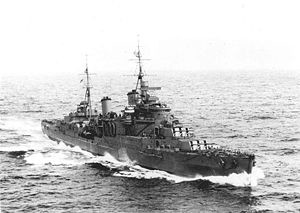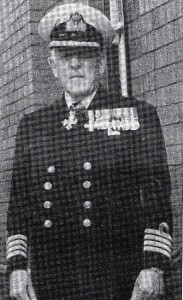If you visit Morton Church you will see the flag of HMS Manchester hanging from its wall and you may wonder what connects this church and the 12000 ton Town-class light cruiser which went down off the coast of Tunisia on 13th August 1942. The answer is the ship’s captain Harold ‘Peter’ Drew.
Born in Oswestry on 15th March 1895, Harold was the son of Charles Drew, who in the late 19th century and early 20th century was a local wine merchant and owner of the Wynnstay Hotel, Oswestry. Charles also went on to establish Drew’s Mineral Water Company in King Street.
Harold joined the Royal Naval Reserve in 1915, transferring to the Royal Navy in July of the following year as Midshipman number 1909. In his records it was noted that he ‘performed his duties well and had a knowledge of French’. His first assignment was with

This historic vessel was built as a motor torpedo boat for the Royal Navy in 1916 by Thornycroft, named CMB9. She is of double diagonal mahogany construction and was one of twelve such vessels ordered by The Admiralty. She was based at Osea Island on the River Blackwater in Essex.
Coastal Motor Boat 9 (CMB9) a small motorboat, carrying a torpedo, which was capable of travelling over mine fields [1].
In May 1917 he was awarded the Distinguished Service Order (DSO) for ‘miscellaneous services’ and later that year transferred to the Iron Duke-class battleship, ‘HMS Emperor of India’, the second flagship of the First Battle Squadron. By the end of the war he had risen to the rank of Lieutenant and after the war he spent a short time at Cambridge University. He then transferred to the naval shore establishment HMS Pembroke at Chatham.
In March 1926 he was promoted to the rank of Lieutenant Commander seeing service aboard HMS Suffolk and HMS Sovereign and just under six years later he became a Commander, returning to work ashore where, as a gunnery specialist, he developed an automatic fuze setter (not subsequently taken up by the navy). With war looming, in June 1939, he attained the rank of Captain and in 1941 was assigned to take command of the newly refitted HMS Manchester.
Alerted by naval intelligence that a major German naval operation was underway, HMS Manchester became part of a force sent to patrol the Iceland-Faroes passage and the Denmark Strait in an attempt to block the German breakout into the Atlantic. In July she was directed to the Mediterranean, but on 23rd of that month, whilst escorting an eastbound Malta convoy, she was struck on the port side by an aerial torpedo and badly damaged. She managed to reach Gibraltar where temporary repairs were effected, then she sailed for Philadelphia for complete repair. In February 1942, HMS Manchester returned to Portsmouth, where final work was completed and by the end of April she was able to return to service, rejoining the Home Fleet at Scapa Flow during the first week of May. Here she carried out Russian convoy cover duties and the reinforcement of Spitzbergen.
In July or early August Captain Drew received orders to make for the Mediterranean in order to join the large naval force that was being assembled to provide the escort for Operation Pedestal, a British operation to get desperately needed supplies to the island of Malta. About a day out from Gibraltar, an Italian reconnaissance plane was spotted checking up on the convoy’s position and composition. Then on the afternoon of 11 August, the aircraft carrier HMS Eagle was hit by four torpedoes from the German submarine U-73 . Next day, the flagship of the closed escort group, HMS Nigeria was torpedoed and damaged by an Italian submarine. At about 0100 hours, the next day, about 4 nautical miles east of Kelibia, near Cape Bon, Tunisia, HMS Manchester was torpedoed and the after engine room and adjacent compartments, including the oil fuel tanks and the 4-inch magazines, flooded immediately. Two of the dynamos were put out of action and only the port outer shaft was in operation. The ship took on a list of 12 degrees to starboard. Using emergency power the list was reduced to 5 degrees by counter flooding, unfortunately it proved impossible to restore main power and as three out of four shafts were permanently out of action Captain Drew took the decision to abandon the ship and scuttle her. Taking to the lifeboats with 27 officers and 375 men, he got ashore in Tunisia where he was immediately taken prisoner by the Vichy French and held in a POW camp until freed by the Allies during Operation Torch.
On returning to Britain, Harold Drew was summoned to what he thought was merely a Board of Inquiry; he was actually facing a Court Martial [2], the verdict of which was placed on his naval record:
‘Court Martial – 20th February 1943 – Loss of HMS Manchester. Finding – negligently performed duty as Commanding Officer. Gave orders for HMS Manchester to be abandoned and scuttled when having regard for conditions prevailing at the time, it was his duty to stand by the ship and do his utmost to bring her into harbour’
He was severely reprimanded and it was noted on his record that he was never again to be appointed to a command aboard ship. Following his court martial he was appointed as Captain in charge of Maintenance at Scapa Flow and later given a staff appointment in Bombay working with the Indian Navy.
Harold was awarded the CBE in the 1946 New Year’s Honours List, for his work as Chairman of the Victory Celebration Committee and was subsequently appointed Director of Naval Recruiting. In 1948 he became ADC to King George VI and then Deputy Commander-in-Chief of the Indian Navy with the acting rank of Commodore. On 1st September 1952 he was finally placed on ‘the retired list’ and returned to live in Oswestry where he remained until his death in 1987 at the age of 92.
For many years controversy has raged over the Admiralty’s court martial of Harold Drew. Many of his former crew have, in later years, put on record their belief that his decision to scuttle HMS Manchester was the correct one and in 2002 a dive on the wreck found that the damage she had received was so severe it was most unlikely that she could have made it safely to port.
© Pamela M. Willing 2015
[1] Coastal Motor Boat 9, later designated DCB1 has been lovingly restored by her owner who has set up a Facebook page detailing the restoration work. This can be viewed at: https://www.facebook.com/pages/CMB-9-DCB1/433214220119517?fref=ts
[2] Although it is stated that Harold Drew was not expecting to face a Court Martial, this does seem to be normal procedure when a ship is lost. Following the sinking of HMS Ark Royal in 1941, Loben E H Maund, her captain, was subsequently court-martialled. He was found guilty on two counts of negligence: one of failing to ensure that properly constituted damage control parties had remained on board after the general evacuation, and one of failing to ensure the ship was in a sufficient state of readiness to deal with possible damage. The board tempered their judgment with an acknowledgement that a high standard was being expected of Maund, and that he was primarily concerned with the welfare of his crew.
Sources used
National Archives Document ADM 340/43/26
National Archives Document ADM 196/146/446
National Archives Document ADM 196/96/120
National Archives Document ADM 196/55/38
Border Counties Advertizer dated 28th August 2002
Border Counties Advertizer dated 21st July 2009
Man o’ War 5 Town Class Cruisers by Alan Raven and John Roberts
More newspaper articles can be seen on our Photo Albums page where you will find an album entitled Drew-Commodore Harold


